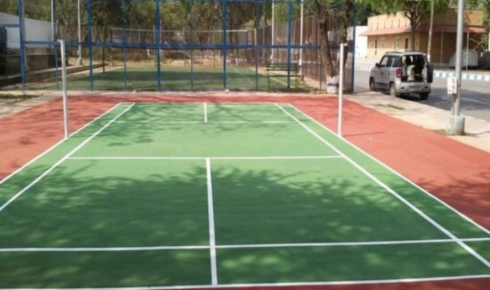Badminton is a sport that demands agility, speed, and precision—and none of these are possible without a high-quality playing surface. Whether you’re planning a court for a school, sports academy, club, or a private facility, selecting the right badminton court construction company can make or break the entire project. From material selection to surface quality and safety compliance, several factors influence the performance and longevity of the court.
In this guide, we’ll walk you through everything you need to know before choosing a badminton court construction partner, with a special focus on the benefits of synthetic acrylic flooring, which has become the go-to option for both indoor and outdoor badminton courts.
Indoor vs Outdoor Badminton Courts: Start with the Setting
The very first thing you need to consider is the location of the court—indoor or outdoor. This will significantly influence the construction method and choice of flooring material.
- Indoor courts are typically built in gyms, auditoriums, or covered stadiums. These are protected from direct sunlight and rainfall, so the emphasis is more on performance and aesthetics.
- Outdoor courts, on the other hand, require materials that can withstand weather changes, UV exposure, and surface wear. Drainage, slope, and surface resilience become critical factors.
Understanding this distinction is crucial before approaching any contractor, as not all companies specialize in both formats.
What Makes a Good Badminton Court?
A well-constructed badminton court flooring must offer:
- Consistent surface grip
- Balanced shock absorption
- Durable finish
- Proper line markings
- Compliance with BWF (Badminton World Federation) dimensions
These features don’t just depend on the skill of the contractor, but also on the type of flooring material used.
Synthetic Acrylic: A Superior Flooring Choice
Among the various flooring materials available today, synthetic acrylic has emerged as the most reliable and cost-effective option—especially for outdoor badminton courts, and increasingly for indoor ones too.
Here’s why synthetic acrylic stands out:
- Slip Resistance: The textured coating ensures excellent traction, reducing the risk of player injuries during rapid movement and sudden stops.
- Durability: Acrylic layers are resistant to peeling, cracking, and UV damage. This is particularly beneficial for Indian climates, where heat and humidity are frequent.
- Customizability: Acrylic coatings come in multiple colors, allowing courts to be customized to your brand or institution’s aesthetic.
- Low Maintenance: These courts are easy to clean and require minimal upkeep compared to wooden or PU floors.
- Cost-Efficient Over Time: Though not the cheapest at installation, the long lifespan and reduced maintenance needs make synthetic acrylic a smart investment.
Whether it’s an academy training juniors or a housing society looking for a durable solution, synthetic acrylic is the versatile choice.
Red Flags: What to Avoid in a Construction Company
Not every construction company is equipped to deliver a professional-grade badminton court. Here are some warning signs to look out for:
- Unclear material details: If the contractor is vague about the type or quality of flooring material, it’s a big red flag.
- No experience with sports flooring: General civil contractors may lack the technical understanding required for precision court flooring.
- Improper base work: Laying the right concrete base (usually M20 or M25 grade) is essential before acrylic application. Poor groundwork can lead to surface cracks and uneven play.
- Lack of certifications or standards: Make sure they follow BWF specifications and local safety norms.
- No after-sales support: A good company should offer basic after-installation maintenance tips and be available for troubleshooting.
What to Expect from a Professional Badminton Court Contractor
A credible badminton court construction company should provide:
1. Site Evaluation
Before starting, they should inspect the proposed site, take accurate measurements, and assess drainage, sunlight exposure, and land leveling.
2. Base Construction
This usually involves:
- Grading and leveling
- Laying a concrete slab (with proper thickness and slope)
- Ensuring water drainage solutions for outdoor courts
3. Surface Coating
Using high-quality synthetic acrylic materials, the contractor should apply multiple coats for:
- Cushioning (optional)
- Surface texture
- Color coating
- Game lines and markings
4. Finishing & Quality Checks
Post-coating, the surface should be tested for bounce, grip, and slip resistance. Line markings should be clear and comply with official dimensions.
5. Maintenance Guidance
A good company won’t leave you guessing. They’ll provide a maintenance plan to ensure your court lasts for years, including cleaning, recoating timelines, and how to deal with minor wear and tear.
Questions to Ask Before Hiring
Don’t hesitate to ask potential contractors these questions:
- What materials do you use? (Look for synthetic acrylic.)
- How many courts have you constructed before?
- Do you offer post-construction support?
- Can I see previous projects or client references?
- What is the expected life of the court and warranty on materials?
These questions not only reveal the contractor’s expertise but also show how transparent they are with the process.
Cost Considerations
While pricing can vary depending on location, court size, and optional features (like fencing, lighting, or covered roofing), synthetic acrylic courts are competitively priced. They generally offer the best value for money when considering both upfront cost and lifecycle performance.
Avoid the trap of low-budget deals using substandard paints or epoxy layers marketed as “sports coatings.” They may look good initially but will fail to perform in the long run.
Final Thoughts
Constructing an outdoor badminton court flooring is a long-term investment in sports infrastructure. Choosing a specialized badminton court construction company that uses high-grade synthetic acrylic flooring ensures that your court not only meets performance standards but also stands the test of time.
From better player experience to reduced maintenance efforts, the right material and expert execution will pay dividends for years. Take your time to research, ask questions, and prioritize quality over shortcuts.

